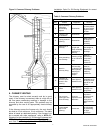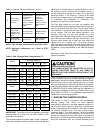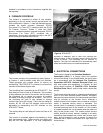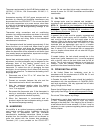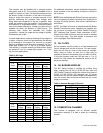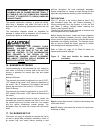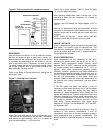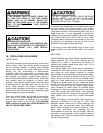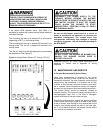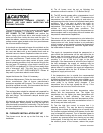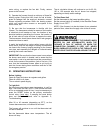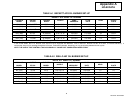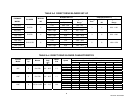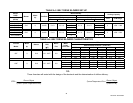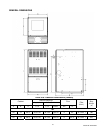
29733 R2 06/01/2003
14
IF THE FURNACE FAILS TO IGNITE, CHECK THE
OIL TANK FUEL GAUGE. IF THE FUEL GAUGE
SHOWS THAT OIL IS PRESENT, PRESS THE
RESET BUTTON ONCE ONLY. IF THE BURNER
FAILS TO IGNITE, CONTACT YOUR SERVICE
CONTRACTOR.
ALL FURNACE CONTROLS ARE SENSITIVE AND
SHOULD NOT BE SUBJECTED TO TAMPERING. IF
PROBLEMS PERSIST, CALL YOUR SERVICE
CONTRACTOR.
18. CIRCULATING AIR BLOWER
DIRECT DRIVE
The HO-B furnaces may be equipped with a direct drive
blower system. Direct drive blower speed adjustments
are not normally required in properly sized extended
plenum duct systems. The motor RPM and air CFM
delivery will vary automatically to accommodate
conditions within the usual range of external static
pressures typical of residential duct systems. Under-sized
duct systems may require a higher blower speed to
obtain a reasonable system temperature rise. Some older
duct systems were not designed to provide static
pressure. They typically feature special reducing fittings
at each branch run and lack block ends on the trunk
ducts. These systems may require modification to
provide some resistance to the airflow to prevent over-
amping of the direct drive blower motor. Selecting a lower
blower speed may correct this problem.
Direct drive blower speeds are adjusted by changing the
"hot" wires to the motor winding connections. Please
refer to wiring diagram in Appendix B or the wiring
diagram label affixed to the furnace. THE NEUTRAL
WIRE (normally the white wire) IS NEVER MOVED TO
ADJUST THE BLOWER SPEED.
DO NOT CONNECT POWER LEADS BETWEEN
MOTOR SPEEDS. THE NEUTRAL WIRE MUST
ALWAYS BE CONNECTED TO THE MOTOR'S
DESIGNATED NEUTRAL TERMINAL.
It is possible and acceptable to use a single blower speed
for both heating and cooling modes. The simplest
method to connect the wiring from both modes is to use a
"piggy-back connector" accommodating both wires on a
single motor tap. It is also acceptable to connect the
selected motor speed with a pigtail joined to both heating
and cooling speed wires with a wire nut. As a safety
precaution against accidental disconnection of the wires
by vibration, it is advisable to secure the wire nut and
wires with a few wraps of electricians tape.
If the joining of the blower speed wiring is done in the
furnace junction box, tape off both ends of the unused
wire.
BELT DRIVE
The HO-B Models are available with an optional belt drive
blower assembly. Belt drive blower systems can be
modified for a variety of speeds and air delivery by
adjusting the variable speed motor pulley, and / or by
changing the blower pulley.
The variable speed motor pulley may be adjusted by
loosening the 5/32 Allen set screw in the outer sheave,
and turning the outer sheave clockwise to increase
blower speed; counter clockwise to reduce blower speed.
Ensure that the setscrew is tightened at one of the "flat
spots", failure to do so will convert the variable speed
pulley to a fixed speed pulley by ruining the threads.
Changing the blower pulley can also modify the blower
speed. A smaller blower pulley will cause the blower to
turn faster; a larger pulley will reduce blower speed.
Large increases in blower speed will increase power
requirements. Check the amperage draw of the blower
motor after changes have been made. If the amperage
draw is greater than the value listed on the motor rating
plate, replace with a motor with a higher horsepower
rating.
The fan belt tension is very important. There should be a
deflection of between ¾ of an inch to 1 inch. Less
deflection places a strain on the blower bearings, and
increases start up amperage draw. More deflection
allows excess slippage and causes premature motor
pulley wear. Automotive belt dressings are not
recommended. A hard soap such as Sunlight
®
soap will
work well as a belt dressing, for the purpose of reducing
belt squeaks, etc. If used, the soap should be applied to
the sides of the belt only.




